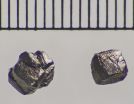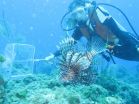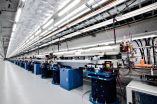INFORMATION:
Gruverman's UNL co-authors included Haidong Lu and Dong Jik Kim, postdoctoral researchers in physics and astronomy; Alexey Lipatov, a postdoctoral researcher in chemistry; Evgeny Tsymbal, George Holmes University Professor of physics and astronomy; and Alexander Sinitskii, assistant professor of chemistry. The study was also authored by researchers from the University of Wisconsin-Madison and the Moscow-based Kurnakov Institute for General and Inorganic Chemistry.
The team's research was conducted with the assistance of UNL's Materials Research Science and Engineering Center -- part of a nationwide network of MRSECs sponsored by the National Science Foundation -- and also received support from the U.S. Department of Energy.
Nature Communications is the Nature Publishing Group's multidisciplinary online journal of research in all areas of the biological, physical and chemical sciences.
WRITER: Scott Schrage, University Communications
Physicists and chemists work to improve digital memory technology
Electrodes made of graphene
2014-11-24
(Press-News.org) Lincoln, Neb., Nov. 24, 2104 -- The improvements in random access memory that have driven many advances of the digital age owe much to the innovative application of physics and chemistry at the atomic scale.
Accordingly, a team led by University of Nebraska-Lincoln researchers has employed a Nobel Prize-winning material and common household chemical to enhance the properties of a component primed for the next generation of high-speed, high-capacity RAM.
The team, which published its findings in the Nov. 24 edition of the journal Nature Communications, engineered and tested improvements in the performance of a memory structure known as a ferroelectric tunnel junction.
The junction features a ferroelectric layer 100,000 times thinner than a sheet of paper, so thin that electrons can "tunnel" through it. This layer resides between two electrodes that can reverse the direction of its polarization -- the alignment of positive and negative charges used to represent "0" and "1" in binary computing -- by applying electric voltage to it.
The researchers became the first to design a ferroelectric junction with electrodes made of graphene, a carbon material only one atom thick. While its extreme conductivity makes graphene especially suited for small-scale electronics, the authors' primary interest lay in how it accommodated nearly any type of molecule -- specifically, ammonia -- they placed between it and the ferroelectric layer.
A junction's polarity determines its resistance to tunneling current, with one direction allowing current to flow and the other strongly reducing it. The researchers found that their graphene-ammonia combination increased the disparity between these "on" and "off" conditions, a prized outcome that improves the reliability of RAM devices and allows them to read data without having to rewrite it.
"This is one of the most important differences between previous technology that has already been commercialized and this emergent ferroelectric technology," said Alexei Gruverman, a Charles Bessey Professor of physics who co-authored the study.
Ferroelectric materials naturally boast the quality of "non-volatility," meaning they maintain their polarization -- and can hence retain stored information -- even in the absence of an external power source. However, the infinitesimal space between the positive and negative charges in a tunnel junction makes maintaining this polarization especially difficult, Gruverman said.
"In all memory devices, there is a gradual relaxation, or decrease, of this polarization," he said. "The thinner the ferroelectric layer is, the more difficult it is to keep these polarization charges separate, as there is a stronger driving force in the material that tries to get rid of it."
Gruverman said the team's graphene-ammonia combination also shows promise for addressing this prevalent issue, significantly improving the stability of the junction's polarization during the study.
ELSE PRESS RELEASES FROM THIS DATE:
Babies remember nothing but a good time, study says
2014-11-24
Parents who spend their time playing with and talking to their five-month-old baby may wonder whether their child remembers any of it a day later.
Thanks to a new BYU study, we now know that they at least remember the good times.
The study, published in Infant Behavior and Development, shows that babies are more likely to remember something if there is a positive emotion, or affect, that accompanies it.
"People study memory in infants, they study discrimination in emotional affect, but we are the first ones to study how these emotions influence memory," said BYU psychology ...
Can stress management help save honeybees?
2014-11-24
Honeybee populations are clearly under stress--from the parasitic Varroa mite, insecticides, and a host of other factors--but it's been difficult to pinpoint any one of them as the root cause of devastating and unprecedented losses in honeybee hives. Researchers writing in the Cell Press journal Trends in Parasitology on November 24th say that the problem likely stems from a complex and poorly understood interplay of stresses and their impact on bee immunity and health. It's a situation they suspect might be improved through stress management and better honeybee nutrition.
As ...
Study finds most older adults qualify for statin therapy under new cholesterol guidelines
2014-11-24
MINNEAPOLIS, MN - November 24, 2014 - Nearly all individuals in their late 60s and early 70s -- including 100 percent of men -- now qualify for and should consider starting a statin medication to reduce their risk of cardiovascular disease, under the recently released cholesterol guidelines from the American College of Cardiology (ACC) and the American Heart Association (AHA).
That's according to a research letter published today in the 11/20/2014 (JAMA-IM) by Michael D. Miedema, MD, MPH, a research cardiologist at Minneapolis Heart Institute Foundation and cardiologist ...
Selenium compounds boost immune system to fight against cancer
2014-11-24
The immune system is designed to remove things not normally found in the body. Cells undergoing change, e.g. precursors of cancer cells, are therefore normally recognised and removed by the immune system. Unfortunately, the different cancer cells contain mechanisms that block the immune system's ability to recognise them, allowing them to freely continue cancer development.
Certain cancer cells overexpress immunostimulatory molecules in liquid form. Such over-stimulation has a negative impact on the immune system:
"You can say that the stimulating molecules over-activate ...
Bad news for kids
2014-11-24
The degree to which parents sacrifice themselves for their children depends on a variety of factors. On the one hand nest predators pose a threat to the young and the parent birds. But also the time of hatching plays a role. Earlier studies have shown that birds born late in the season are more likely to be protected by their parents, as the adult birds often do not have the chance to produce replacement clutches. Older offspring also tend to be protected more readily than younger ones, as much more parental care and energy have already been invested.
"Studies on the ...
Asteroid impacts on Earth make structurally bizarre diamonds
2014-11-24
Scientists have argued for half a century about the existence of a form of diamond called lonsdaleite, which is associated with impacts by meteorites and asteroids. A group of scientists based mostly at Arizona State University now show that what has been called lonsdaleite is in fact a structurally disordered form of ordinary diamond.
The scientists' report is published in Nature Communications, Nov. 20, by Péter Németh, a former ASU visiting researcher (now with the Research Centre of Natural Sciences of the Hungarian Academy of Sciences), together with ASU's ...
Lionfish analysis reveals most vulnerable prey as invasion continues
2014-11-24
CORVALLIS, Ore. - If you live in lionfish territory in the Atlantic Ocean, the last thing you want to be is a small fish with a long, skinny body, resting by yourself at night, near the bottom of the seafloor.
If so, your chances of being gobbled up by a lionfish increase by about 200 times.
Findings of a study on lionfish predation behavior, which may also apply to some other fish and animal species, have shed some new light on which types of fish are most likely to face attack by this invasive predator, which has disrupted ecosystems in much of the Caribbean Sea and ...
Preconception care for diabetic women could potentially save $5.5 billion
2014-11-24
Philadelphia, PA, November 24, 2014 - Pregnant women with diabetes are at an increased risk for many adverse birth outcomes. Preconception care (PCC) can significantly lower these risks by helping pregnant mothers with diabetes control their glucose levels, resulting in healthier babies and less money spent on complicated deliveries and lifelong medical complications. Effective, universal PCC for diabetic mothers could avert an estimated $5.5 billion in health expenditures and lost employment productivity over affected children's lifetimes, according to a new study published ...
Ultra-short X-ray pulses explore the nano world
2014-11-24
This news release is available in German.
X-ray flashes are a unique scientific tool. They are generated by accelerating electrons to very high energy levels in kilometer-long vacuum tubes, so-called linear accelerators, and then deflecting them with specially arranged magnets. In the process the particles emit X-ray radiation that is amplified until an ultra-short and intensive X-ray flash is released.
Researchers use these X-ray flashes to resolve structures as small as one ten billionth of a meter (0.1 nanometer) in size. That is roughly the diameter of a ...
Pain and itch in a dish
2014-11-24
LA JOLLA, CA--November 24, 2014--A team led by scientists from The Scripps Research Institute (TSRI) has found a simple method to convert human skin cells into the specialized neurons that detect pain, itch, touch and other bodily sensations. These neurons are also affected by spinal cord injury and involved in Friedreich's ataxia, a devastating and currently incurable neurodegenerative disease that largely strikes children.
The discovery allows this broad class of human neurons and their sensory mechanisms to be studied relatively easily in the laboratory. The "induced ...
LAST 30 PRESS RELEASES:
Baby sharks prefer being closer to shore, show scientists
UBC research helps migrating salmon survive mortality hot-spot
Technical Trials for Easing the (Cosmological) Tension
Mapping plant functional diversity from space: HKU ecologists revolutionize ecosystem monitoring with novel field-satellite integration
Lightweight and flexible yet strong? Versatile fibers with dramatically improved energy storage capacity
3 ways to improve diabetes care through telehealth
A flexible and efficient DC power converter for sustainable-energy microgrids
Key protein regulates immune response to viruses in mammal cells
Development of organic semiconductors featuring ultrafast electrons
Cancer is a disease of aging, but studies of older adults sorely lacking
Dietary treatment more effective than medicines in IBS
Silent flight edges closer to take off, according to new research
Why can zebrafish regenerate damaged heart tissue, while other fish species cannot?
Keck School of Medicine of USC orthopaedic surgery chair elected as 2024 AAAS fellow
Returning rare earth element production to the United States
University of Houston Professor Kaushik Rajashekara elected International Fellow of the Engineering Academy of Japan
Solving antibiotic and pesticide resistance with infectious worms
Three ORNL scientists elected AAAS Fellows
Rice bioengineers win $1.4 million ARPA-H grant for osteoarthritis research
COVID-19 booster immunity lasts much longer than primary series alone, York University-led study shows
Bentham Science joins United2Act
When thoughts flow in one direction
Scientists identify airway cells that sense aspirated water and acid reflux
China’s major cities show considerable subsidence from human activities
Drugs of abuse alter neuronal signaling to reprioritize use over innate needs
Mess is best: disordered structure of battery-like devices improves performance
Skyrmions move at record speeds: a step towards the computing of the future
A third of China’s urban population at risk of city sinking, new satellite data shows
International experts issue renewed call for Global Plastics Treaty to be grounded in robust science
Novel material supercharges innovation in electrostatic energy storage
[Press-News.org] Physicists and chemists work to improve digital memory technologyElectrodes made of graphene




